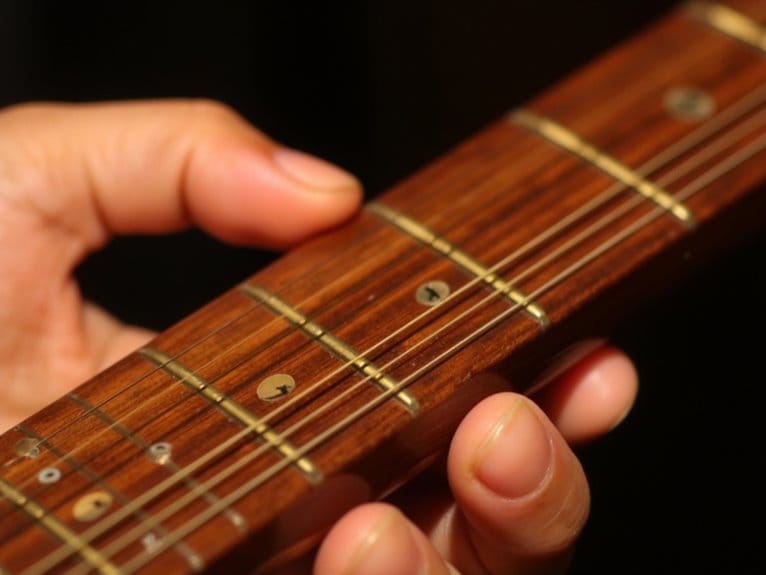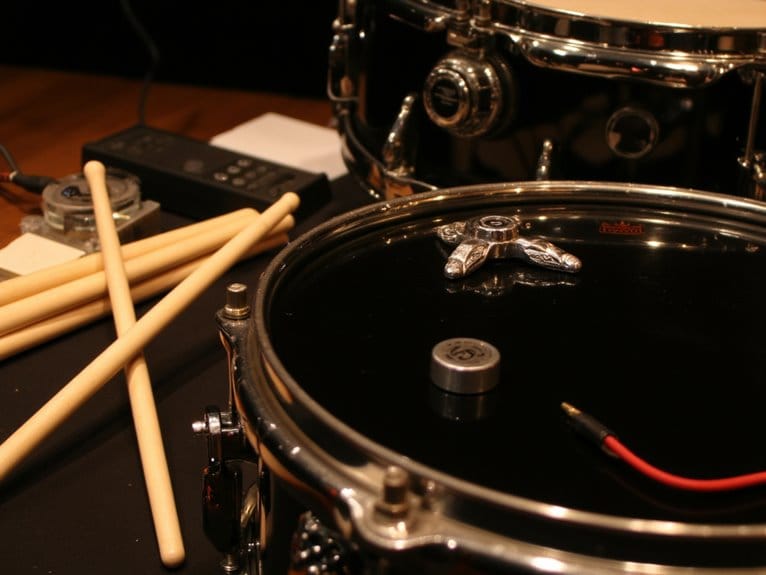Tapping Techniques for Non-Metal Players
You’ll discover that tapping isn’t just for metal shredders-it’s a versatile technique that transforms your fretting approach across jazz, funk, and ambient genres. By treating both hands as fretting tools, you’ll create intricate counterpoint melodies and rhythmic complexity that traditional picking can’t achieve. Focus on relaxed hand positioning with low wrists, controlled finger velocity for tonal clarity, and multi-finger approaches for layered compositions that’ll expand your musical expression beyond conventional boundaries.
We are supported by our audience. When you purchase through links on our site, we may earn an affiliate commission, at no extra cost for you. Learn more.
Notable Insights
- Jazz fusion players use tapping for rapid arpeggiated passages and complex melodic lines across chord progressions.
- Funk musicians incorporate percussive taps to add rhythmic complexity and syncopated grooves to their playing style.
- Pop artists create memorable signature riffs using tapping techniques combined with catchy melodic hooks and progressions.
- Ambient musicians enhance tapping with delay and reverb effects to explore new sonic territories and atmospheric textures.
- Multi-finger tapping enables independent hand melodies, creating layered compositions and counterpoint arrangements across all genres.
Fundamentals of Tapping Across Different Instruments
While most musicians associate tapping with flashy guitar solos, I’ve discovered that this versatile technique actually transforms how you can approach nearly any stringed instrument, opening doors to polyphonic possibilities that traditional fingering simply can’t match.
When you master tapping basics, you’re fundamentally turning both hands into fretting tools, which allows you to play counterpoint melodies that would make Bach proud. The finger coordination required might feel awkward initially, but I’ve found that treating your right hand like additional fret fingers rather than a picking mechanism changes everything.
Whether you’re working on handpan percussion or experimenting with Chapman Stick techniques, the fundamental principle remains consistent: controlled finger placement and velocity determine your tonal clarity and dynamic expression across all instruments. Just as string gauge selection affects tension and playability for extended-range guitar techniques, choosing the right string specifications for your instrument will significantly impact your tapping precision and overall performance quality.
Essential Hand Positioning and Ergonomic Practices
Once you’ve grasped the fundamental principles of tapping across instruments, I’ve learned that proper hand positioning becomes the foundation that determines whether you’ll develop fluid technique or fight against your own anatomy for years.
Your hand posture should remain relaxed with your arm hanging loosely, creating minimal muscular tension during tapping sequences. I’ve found that positioning your wrist low enables more effective finger control, particularly when you’re using fingertip or DIP joint tapping styles that require precision.
Focus on wrist movement rather than elbow motion for finger percussion, as this approach reduces strain considerably. Keep your thumb extended but avoid excessive joint movements, and maintain that semipronated position with digits extended for ideal stability and accuracy.
Advanced Techniques for Musical Expression
After establishing solid fundamentals, I’ve discovered that advancing your tapping technique requires embracing multi-finger approaches that transform simple melodies into complex, layered compositions. You’ll find that melodic interplay becomes natural when both hands work independently, creating that coveted “wall of sound” effect through harmonic density.
| Technique | Primary Benefit |
|---|---|
| Multi-finger tapping | Complex patterns and richer textures |
| Double-handed sequences | Independent melodic lines |
| Legato integration | Seamless shifts at speed |
| Odd-note groupings | Enhanced rhythmic exploration |
| Pattern variation | Personal voice development |
Breaking down intricate passages into manageable sections, you’ll develop coordination that enables polyrhythmic textures and contrapuntal solos. I’ve found that combining hammer-ons with tapping maintains clarity while exploring quintuplets and septuplets, expanding your rhythmic vocabulary beyond standard subdivisions. Just as a quality microphone captures the full frequency response of your playing when recording these techniques, proper equipment selection becomes crucial for documenting your progress and sharing your musical expression with others.
Genre Applications and Creative Possibilities
These advanced techniques I’ve outlined open doors to remarkable applications across musical genres where tapping isn’t traditionally expected. I’ve personally witnessed how non-metal players can harness these skills to create genuinely innovative sounds.
Jazz fusion guitarists, for instance, use tapping styles to execute rapid arpeggiated passages that would challenge even seasoned fingerpickers. Meanwhile, funk players incorporate percussive taps to generate rhythmic complexity that makes their grooves absolutely infectious.
I’ve seen pop musicians apply tapping to craft memorable signature riffs, and progressive rock bands layer polyphonic patterns that create those intricate soundscapes their audiences crave.
You’ll discover that combining tapping with effects like delay and reverb opens entirely new sonic territories, particularly in ambient genres where traditional picking simply can’t achieve the same ethereal textures.
On a final note
You’ve now got the foundational knowledge to integrate tapping into your musical vocabulary, regardless of whether you’re wielding sticks, mallets, or using your bare hands. I’ve found that consistent practice with proper ergonomics yields the most sustainable results, though don’t expect overnight mastery-I certainly didn’t achieve it quickly. Start with basic patterns, gradually incorporate advanced techniques, and remember that creative expression often emerges from technical limitations rather than despite them.







